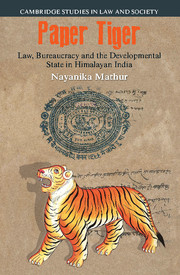Conclusion: The State as a Paper Tiger
Published online by Cambridge University Press: 05 October 2015
Summary
Let me end this book with the question that I have been asked from the day I began research for it: How is the NREGA doing? Is it performing well or not? At the heart of Paper Tiger lies my struggle to answer this question without a measure of reserve; with a sense of adequateness. This struggle is not a shortcoming of this work but, rather, its contribution.
I spent over a year in Uttarakhand tracking the NREGA. I was to emerge from this period with a higher level of incomprehension of its success/failure than I had at the beginning of my fieldwork. In striking contrast, I visited Odisha for less than a month and emerged from that trip with clear ‘findings’. The objective of the Odisha trip was succinctly explained by Jean Dreze; we were there to find out ‘kitnee chori hooen’ (how much theft happened) in the implementation of the NREGS in the state. Research teams fanned out in different Blocks of a total of three districts in the State. Results were swiftly arrived at after a fortnight of intensive surveying. In Kalahandi's Narla Block, where my group undertook an intensive survey, 48 per cent of the labourers’ statements that we recorded did not match the official muster roll. In the rare cases that we were able to locate the job cards, 24.2 per cent of their entries did not match the muster roll, and 12.5 per cent of the names entered in the muster rolls were fake. Gathering together questionnaires for all the Blocks in three districts, and after a daylong brainstorming session with the entire team, Dreze derived concrete results on the performance of the NREGA. They were made public in a meeting with the press and the government at the District Magistrate's office in Boulangir district where he announced that only 60 per cent of the entries in the muster rolls that we sampled had been confirmed by the labourers. He went on to say, ‘I am not implying that 40 per cent chori happened. It could be more or less. Funds are, in any case, being definitely siphoned off’.
- Type
- Chapter
- Information
- Paper TigerLaw, Bureaucracy and the Developmental State in Himalayan India, pp. 165 - 176Publisher: Cambridge University PressPrint publication year: 2015

